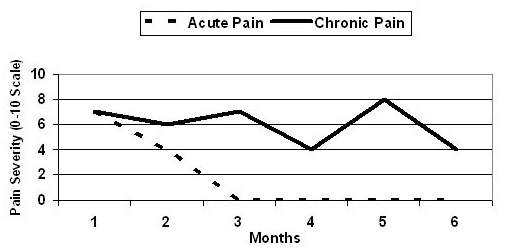Summary
Definition
History and exam
Key diagnostic factors
- duration of pain more than 3 months
- physical comorbidity
- psychological comorbidity
- previous history of acute pain episodes
- pain causing difficulty in performing routine activities of daily living
- precipitating factors for myofascial pain
- precipitating factors for musculoskeletal pain
- herpes zoster infection
- history of trauma or limb immobilization
- drug use
- muscle spasm
- associated somatic symptoms
- muscle tenderness to palpation
- trigger-point tenderness
- taut bands
- twitch response
- joint swelling and tenderness
- tender points
Other diagnostic factors
- precipitating factors for chronic headache
- duration of headache pain
- radiating pain
- morning stiffness in joints
- pain with prolonged walking, relieved with stooping or sitting
- joint pain
- burning quality of pain
- allodynia
- hyperalgesia
- chronic headache associated with nausea, vomiting, and sensitivity to light and noise
- intermittent pattern of chronic headache pain
- bilateral chronic headache pain
- unilateral chronic headache pain
- limited range of motion (ROM)
- painful or limited straight leg raising
- symmetrical body pain distribution
- worsening headache symptoms despite treatment
- headache with posterior head or neck pain
- excessive guarding of the painful extremity
- diminution or loss of reflexes
- tenderness over temporal artery distribution
Risk factors
- age over 45 years
- female sex
- pregnancy
- history of trauma or chronic pain
- family history of chronic pain syndromes
- acute back pain with neurologic signs
- high-risk occupation
- comorbid personality disorder/psychological distress
- pain-related disability
- cigarette smoking
Diagnostic tests
Tests to consider
- plain x-rays of spine, bones, and/or joints
- MRI of spine
- electromyogram and nerve conduction studies
Treatment algorithm
myofascial pain
musculoskeletal pain
neuropathic pain
fibromyalgia
chronic headache
Contributors
Authors
Gaurav Chhabra, MBBS, FRCA, FFPMRCA
Consultant, Pain Medicine and Anaesthesia
North Bristol NHS Trust
Bristol
UK
Disclosures
GC declares that they have no competing interests.
Acknowledgements
Dr Gaurav Chhabra would like to gratefully acknowledge Dr Sarah Love-Jones and Dr Dawn A. Marcus, previous contributors to this topic.
Disclosures
SLJ has received consultancy fees for Boston Scientific and Nevro Corporation (regarding spinal cord stimulation) and is an elected council member of the British Pain Society. DAM is an author of a reference cited in this topic.
Peer reviewers
J. David Sinclair, MD
Clinical Instructor
Department of Anesthesiology
University of Washington School of Medicine
Seattle
WA
Disclosures
JDS declares that he has no competing interests.
Joan Hester, MBBS, FRCA, LRCP, MRCS
Consultant in Pain Management
Pain Unit
King's College Hospital
London
UK
Disclosures
JH has chaired advisory boards for Napp Pharmaceuticals Ltd., chaired a symposium, is a principal investigator and has participated in advisory boards for Grunenthal Ltd., and has given lectures for Pfizer Ltd. JH attended the American Pain Society meeting in 2009 sponsored by Grunenthal.
Beverly J. Collett, MB BS, FRCA, FFPMRCA
Consultant in Pain Medicine
Pain Management Service
University Hospitals of Leicester
Leicester
UK
Disclosures
Not disclosed.
Peer reviewer acknowledgements
BMJ Best Practice topics are updated on a rolling basis in line with developments in evidence and guidance. The peer reviewers listed here have reviewed the content at least once during the history of the topic.
Disclosures
Peer reviewer affiliations and disclosures pertain to the time of the review.
References
Key articles
Headache Classification Committee of the International Headache Society (IHS). The international classification of headache disorders, 3rd edition. Cephalalgia. 2018 Jan;38(1):1-211.Full text Abstract
American Chronic Pain Association; Stanford Medicine. ACPA and Stanford resource guide to chronic pain management: an integrated guide to medical, interventional, behavioral, pharmacologic and rehabilitation therapies. 2021 edition. 2021 [internet publication].Full text
World Health Organization. Guidelines on the management of chronic pain in children. December 2020 [internet publication].Full text
Williams ACC, Fisher E, Hearn L, et al. Psychological therapies for the management of chronic pain (excluding headache) in adults. Cochrane Database Syst Rev. 2020 Aug 12;(8):CD007407.Full text Abstract
Cruccu G, Garcia-Larrea L, Hansson P, et al. EAN guidelines on central neurostimulation therapy in chronic pain conditions. Eur J Neurol. 2016 Oct;23(10):1489-99.Full text Abstract
Reference articles
A full list of sources referenced in this topic is available to users with access to all of BMJ Best Practice.
Differentials
- Hypothyroidism
- Polymyalgia rheumatica (PMR)
- Giant cell arteritis (GCA)
More DifferentialsGuidelines
- Integrative medicine for pain management in oncology
- CDC guideline for prescribing opioids for pain: United States, 2022
More GuidelinesPatient information
Back pain (lower back)
Breast pain
More Patient informationLog in or subscribe to access all of BMJ Best Practice
Use of this content is subject to our disclaimer
